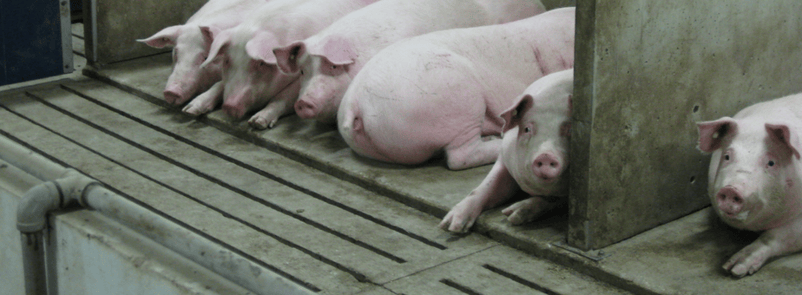
When designing a hog barn or restructuring an existing barn, the animal welfare and comfort should always be top priority and at the front of your mind. At New Standard, the pig comes first when we design our loose housing barns. We believe that the needs of the animals and barn staff are priority number one, yet we also believe that any decision needs to make financial sense. This is why we strive to create efficient, economical and balanced plans tailored to each customer. When you have happy and comfortable pigs and the barn personnel are able to work efficiently, your production will increase and your barn management will become less stressful.
When you design your loose housing barn to meet the animals’ needs first, the sows will respond accordingly. In every facility we have designed and supplied, the pigs noticeably change and grow into the facility. Once the animals and the staff are fully trained, you can see clear evidence that the sows are happier. In fact we have had barn managers comment that they can’t believe the sows have the same DNA as other sites they manage. With our hog barn designs, we meet the sow’s physical and psychological needs. Stress can grow and build like a snowball rolling downhill and one animal’s stress rubs off on the others, so it is essential that we cut identifiable stressors out of the barn during the designing process.
Reducing Stress with Barn Design
We know that increased animal stress leads to many problems in hog production, so we design all aspects of our facilities to reduce each pig’s stress. We meet first with the owners and managers to get an understanding of management styles; then we design each area of the barn to best fit the client and the animals. In the ESF group pens, we design separate areas for gilts and sows to better fit the size and maturity of the animal. Sows, for example, should have around 24 square feet of overall space, whereas gilts do not benefit and perhaps even are hindered by overall space greater than 21.5 square feet. Each area specific to the size of the sow or gilt must be big enough to increase comfort but small enough to keep operations efficient. A dominant sow in any group needs 30 feet of separation in order to feel like she has asserted her authority and the less dominant got the message. With well-designed large pens of 200 or more animals, this sort of space is easy to attain.
The pigs also like to have contact with each other when they are laying down, and within a larger pen, smaller social groups will quickly develop. These social groups of 8-10 sows will typically stay together during their time in the pen. It is important to give the animals the nesting space they need to allow for these types of cliques to develop and be maintained.
Designing the ESF Station Layout
One of the more important aspects of large open sow pens is the relationship of the feed station with the rest of the pen and how that feed station is set up. If they (the feed stations) are not designed into a pen properly, it will cause the whole operation to perform poorly. Poor ESF station application can lead to increased animal stress, long-term digestive issues, and less effective employees. These problems can be avoided if two major aspects of the feed stations are incorporated properly: the feed rationing or dispensing protocols -and- the distance between the entrances and exits of the stations.
Rationing and Dispensing Protocols
When deciding the speed at which the pigs eat, we program to the slowest eater. There is always a small percentage of pigs that consume food slowly and we want even those girls to feel comfortable during their feed time. It is vital that none of the girls are forced to gulp their food or leave some behind because their feed is dispensed at a rate faster than they want to consume it. The gut of the slow animal cannot handle rushed eating, and it does not hurt the faster eaters to slow down. If you were to feed the sows at the average eater’s speed, you could cause digestive issues in a percentage of your group. Along with digestive issues, rushed feeding causes more stress on the slow sow; she will be upset that she was forced to eat quickly or leave some feed behind and she will leave the station irritated. Then she will go mingle with the rest of the girls and rub her anger and stress off on them causing more stress in your barn.
Learn more about Managing Feed Cycles in Your Barn.
Feed Station Entrances and Exits
Larger sow pens with ESF also require that there be maximum separation between the exit from the bank of feed stations and the entrance(s) to those feed stations. When we combine the feed stations into a common exit alley and separation unit, this allows us to create the best pen design. What we like to incorporate is a “social” area for the sows or gilts immediately upon their exit from the feeders. We’ll put the heat detection pen where the girl can interact with a boar in this area. We’ll also have additional watering in the area for anyone who cares for a drink. In this space directly after the exit, a large portion of dunging also takes place. When the animals wander past the social area, they will then walk past the nesting (laying) area. By the time the sow reaches this region of her pen, her food has settled and she is no longer thinking about eating more or getting back to the feed station entrance. Instead she is ready to lay down and relax. This prevents her from interacting with and irritating those waiting in line to eat.
An additional design imperative is the size of the exit alley that the feed stations all flow into. With gilts, we have found that a narrower alley than is typical for sows will prevent a lot of headaches and loss of productive animals. Gilts, being newer to the system and smaller in size, do not always learn good habits immediately and if the alley is too wide, there will come a time when someone attempts to pass another in the alley. Invariably, the pigs will get stuck to the point of causing a traffic jam in the alley and feed stations and will likely lead to some lost gilts. We reduce the gilt alley by three inches to prevent this from happening.
The Quietest Room in the Barn
If every factor is accommodated in the design properly, a loose housing hog barn will out-perform a traditional barn. Loose housing barns benefit you and your staff, but most importantly, they increase the quality of animal welfare. Your sows become healthier and happier, and in turn they are easier to work with. When your pigs are happy, they become calm and surprisingly quiet. In fact, the rooms with all of these animals together are the quietest rooms in the whole facility. When we take visitors on tours of the buildings, they tend to congregate in the rooms with the animals. They are able to talk to each other without shouting, something most people who are familiar with stall barns find fascinating. In our barns, the loudest noise comes from the barn ventilation fans.
The bottom line is your bottom line; happy pigs are productive pigs, happy pigs make happy workers and together that makes happy owners.
If you would like to learn more about how we design hog barns and other swine solutions, please click the button below for a free consultation. We want to provide you with the best solution that fits your operation.





